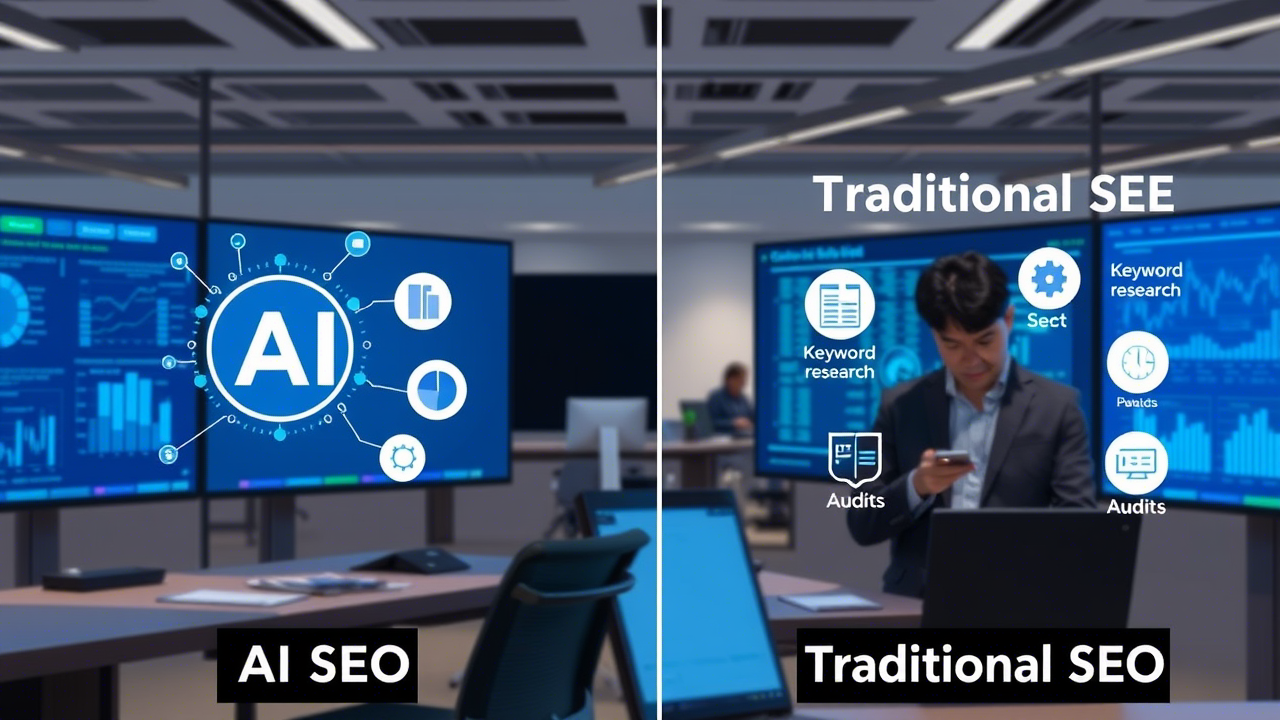In the ever-evolving U.S. digital landscape, SEO (Search Engine Optimization) remains one of the most powerful strategies for driving organic traffic and generating leads online. However, with the rise of Artificial Intelligence (AI) tools—especially natural language models like ChatGPT—the way American businesses approach SEO is undergoing a radical transformation.
So, which is better? AI-powered SEO or traditional human-led methods? Let’s break down the differences, benefits, limitations, and the smartest way forward for the U.S. market.
1. Understanding Traditional SEO
Traditional SEO refers to the manual, human-driven process of optimizing a website and its content to rank on search engines like Google. In the United States, this typically includes:
- Manual keyword research
- Handcrafted content writing
- On-page optimization (titles, meta descriptions, alt tags)
- Link building
- Technical audits and fixes
- User experience optimization
These tasks require experience, creativity, and constant adaptation to Google’s frequently changing algorithms.
Pros of Traditional SEO:
- Deep understanding of U.S.-based brand tone, audience, and niche
- Creative storytelling and emotional connection
- Strategic flexibility tailored to U.S. search trends
- Ethical link-building relationships
Cons:
- Time-consuming and labor-intensive
- Expensive (especially for American small businesses)
- Subject to human error or outdated practices
https://www.youtube.com/watch?v=cfl_wxY6s7s

2. The Rise of AI in SEO
AI SEO uses algorithms and machine learning models to perform SEO tasks faster and, in many cases, more efficiently than humans. Tools like ChatGPT, Jasper, Surfer SEO, Clearscope, and SEMrush AI features are revolutionizing how American marketers:
- Generate keyword-rich content
- Analyze competitors
- Perform site audits
- Discover trending topics specific to the U.S. market
- Optimize for voice and semantic search
What Can AI Do for SEO?
- Keyword Research: Identify long-tail, semantically related keywords in seconds using data from U.S. searches
- Content Generation: Draft blogs, product descriptions, FAQs, and meta tags relevant to American audiences
- SERP Analysis: Scan top-ranking U.S.-based content and reverse-engineer what works
- On-Page Suggestions: Recommend improvements based on NLP (Natural Language Processing)
- Predictive Analytics: Forecast ranking potential and traffic trends in the U.S. market
Pros of AI-Powered SEO:
- Speed and scalability
- Consistent quality (with the right prompts)
- Cost-effective for U.S.-based startups and solopreneurs
- 24/7 availability with no burnout
Cons:
- Limited emotional intelligence
- Risk of generic or duplicated content
- Needs human oversight for brand accuracy
- May lack strategic business insight specific to U.S. customer behavior
3. Direct Comparison: AI vs Traditional SEO
| Feature | AI SEO | Traditional SEO |
|---|---|---|
| Speed | Extremely fast | Slower due to manual work |
| Scalability | High | Limited by team capacity |
| Cost | Lower (after setup) | Higher due to labor |
| Creativity | Limited, template-based | High, human storytelling |
| Strategy | Data-driven, analytical | Experience + intuition-based |
| Accuracy | High with updates | Varies by skill/expertise |
| Brand Voice | Needs training | Naturally maintained |
| Trust Signals | May lack context | Built-in through human writing |

4. The Best Use Cases for AI SEO
AI works best when used to support and speed up repetitive, data-heavy tasks, such as:
- Creating first drafts of content
- Expanding existing blogs with FAQs
- Keyword clustering and topic ideation
- Technical SEO audits and schema markup
- Competitor comparisons in the U.S. market
It’s especially useful for:
- Coaches and consultants in the U.S. needing fast blog content
- Ecommerce brands optimizing thousands of product pages
- Agencies scaling operations across U.S.-based clients
5. Where Traditional SEO Still Wins
AI can’t replace:
- Brand strategy and unique positioning for the American consumer
- Emotional storytelling and copywriting that resonates with U.S. values
- Link-building through real relationships with U.S. publications
- Reputation management on platforms like Yelp and Google Business
- UX/UI decisions based on U.S. customer behavior and feedback
Human expertise adds nuance, context, and ethical judgment—crucial for long-term brand success in the U.S.

6. The Hybrid Approach: Smarter SEO
The real power lies in combining AI and traditional SEO:
Step 1: Use AI to generate keyword ideas and outlines targeting U.S. search trends
Step 2: Have a strategist refine them based on business goals
Step 3: Let AI write drafts—then edit for tone and cultural relevance
Step 4: Use AI tools to audit pages, but let a human prioritize fixes
Step 5: Track performance and adjust with insight from the U.S. market
This hybrid model is:
- Faster than pure manual SEO
- Smarter than AI-only solutions
- More affordable than hiring a full in-house team
7. Real-Life Example: ChatGPT + SEO in Action
Let’s say you’re a wellness coach in California. You want to rank for “holistic nutrition tips.” Here’s how AI + traditional SEO can work together:
- Use ChatGPT to suggest 20 related U.S.-based keywords and blog title ideas.
- Use Surfer SEO to see what content structure works in the U.S. market.
- Generate a 1,500-word draft with ChatGPT.
- Add your personal insights, client stories, and experience.
- Use SEMrush or Ahrefs to audit and improve on-page SEO.
- Publish and monitor with Google Search Console.

8. Final Verdict: Which is Better?
If you’re looking for speed, efficiency, and a solid foundation, AI wins. If you want brand growth, emotional depth, and unique positioning for American consumers, traditional methods win.
But if you want real results in the U.S. market in 2025 and beyond? You need both.
FAQs About AI vs Traditional SEO (U.S. Focus)
Q1: Can AI tools like ChatGPT replace U.S.-based SEO experts?
No. They assist with speed and data, but they lack the strategic and creative thinking of American market experts.
Q2: Is AI-generated content safe for SEO in the U.S.?
Yes—if reviewed and optimized by humans. Avoid plagiarism, add unique value, and ensure cultural relevance.
Q3: Are there risks in using AI for SEO in the U.S. market?
Yes. Risks include repetitive content, keyword stuffing, and tone mismatches. Always review before publishing.
Q4: What are the best AI tools for SEO in 2025 for U.S. businesses?
Top tools include ChatGPT, Surfer SEO, Jasper, Clearscope, Frase, and SEMrush AI integrations.
Q5: How can U.S. beginners start using AI for SEO?
Start by generating keyword lists, blog outlines, meta descriptions, and content ideas using ChatGPT. Always edit before publishing.





